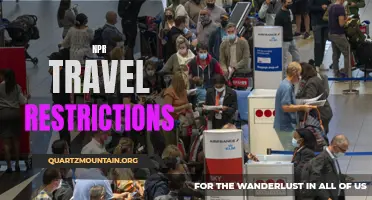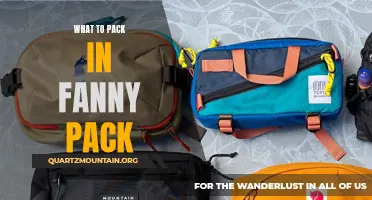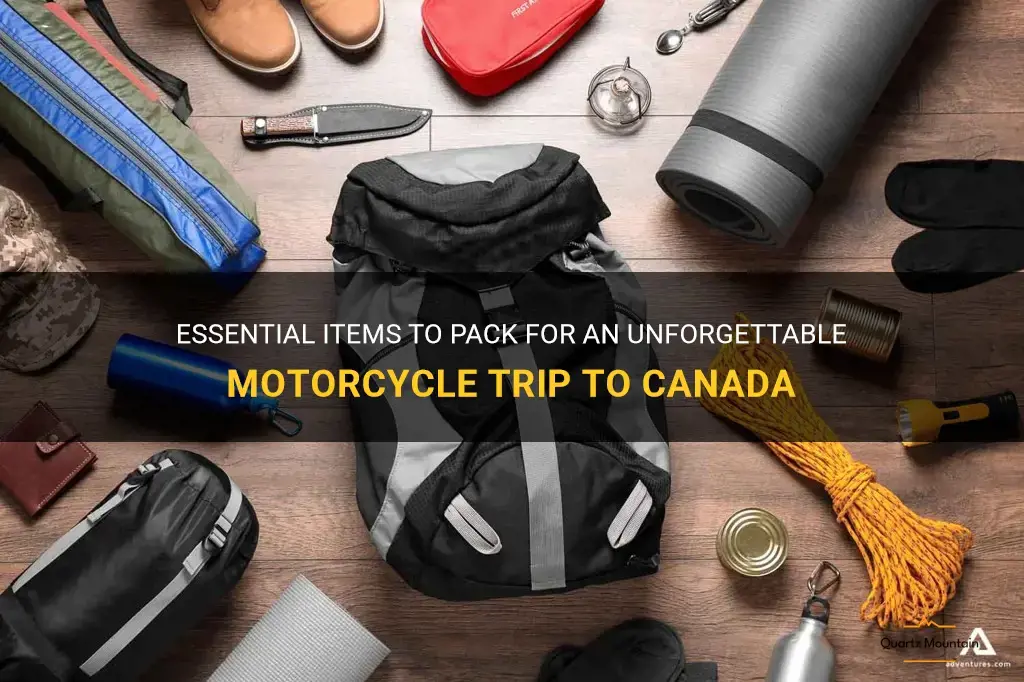
Canada is a vast and beautiful country that offers motorcycle enthusiasts a dream playground for their two-wheeled adventures. From the majestic Rocky Mountains to the stunning coastal roads of British Columbia, there are endless possibilities for unforgettable motorcycle trips in Canada. But before you hop on your bike and hit the road, it's essential to pack the right gear to ensure a safe and enjoyable journey. In this article, we will explore some must-have items that will make your motorcycle trip to Canada truly unforgettable. So grab your helmet, buckle up, and let's get ready to ride!
What You'll Learn
- What are the essential items to pack for a motorcycle trip to Canada?
- Are there any specific clothing recommendations for riding a motorcycle in Canada's climate?
- What tools and spare parts should I bring on a motorcycle trip to Canada to ensure I'm prepared for any breakdowns or repairs?
- Are there any legal requirements or documentation I need to bring with me for a motorcycle trip in Canada?
- Are there any specific safety gear or accessories that are recommended for a motorcycle trip to Canada?

What are the essential items to pack for a motorcycle trip to Canada?
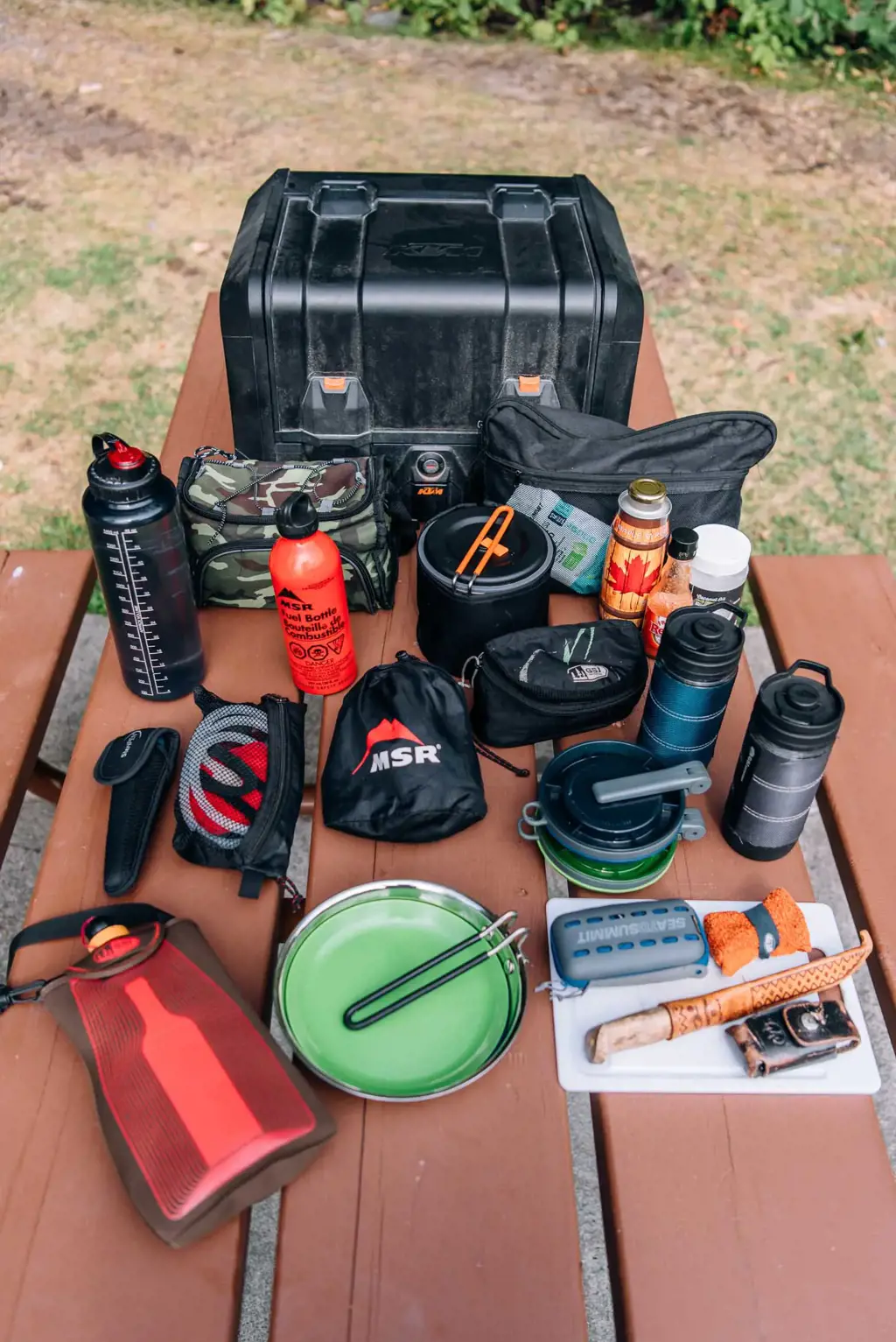
Embarking on a motorcycle trip to Canada can be an exhilarating adventure, allowing you to explore the vast and diverse landscapes of this vibrant country. However, packing for such a journey requires careful consideration of essential items to ensure both comfort and safety throughout your trip. Here, we discuss the must-have items that every motorcycle traveler should pack when visiting Canada.
Protective Gear:
When it comes to protective gear, safety should always be a top priority. In Canada, where weather conditions can vary greatly depending on your location, it is crucial to pack gear that can adapt to different climates. Start with a sturdy helmet that meets safety standards and provides maximum protection. Additionally, invest in a set of armored jackets and pants to shield yourself from potential accidents. Don't forget to pack gloves, boots, and reflective vests for added safety during your ride.
Waterproof Clothing:
Canada is known for its unpredictable weather patterns, so it's essential to pack waterproof clothing. Make sure to bring a good quality rain suit that is both breathable and waterproof. This will protect you from unexpected showers and keep you dry and comfortable throughout your journey.
Layers of Clothing:
Canada experiences distinct seasons, and the temperatures can vary significantly depending on the region and time of year. It is wise to pack clothing that can be layered, allowing you to adjust your outfit accordingly. Pack both warm and lightweight clothing items such as thermal underwear, fleece jackets, and moisture-wicking base layers. This way, you can easily add or remove layers as needed, ensuring your comfort in all weather conditions.
Navigation Tools:
Navigating through unfamiliar terrain is an integral part of any motorcycle trip. Ensure you have reliable navigation tools before embarking on your journey. While GPS devices and smartphone apps can be convenient, it is advisable to pack a physical map as a backup in case of battery failure or signal loss. Familiarize yourself with the routes you plan to take, and carry a compass to help keep you oriented.
Tool Kit and Spare Parts:
Motorcycles, like any other vehicle, require regular maintenance and occasional repairs. Pack a basic tool kit consisting of pliers, screwdrivers, wrenches, and a tire repair kit. Don't forget to carry spare parts such as fuses, bulbs, and cables specific to your motorcycle model. This will allow you to address any minor issues that may arise during your trip, keeping your journey smooth and hassle-free.
First Aid Kit:
Accidents and injuries can happen on any trip, so it is crucial to pack a comprehensive first aid kit. It should include essentials such as bandages, antiseptic ointment, pain relievers, insect repellent, and any necessary personal medication. Familiarize yourself with basic first aid procedures and be prepared to handle minor emergencies.
Camping Gear:
Canada is well-known for its stunning natural beauty, making camping a popular choice for motorcycle travelers. If you plan to camp during your trip, pack essential camping gear such as a lightweight tent, sleeping bag, camping stove, and cookware. Additionally, bring a headlamp, multi-tool, and a compact camping chair to enhance your camping experience.
In summary, when planning a motorcycle trip to Canada, it is important to pack the right gear to ensure comfort, safety, and enjoyment throughout your journey. Focus on protective gear, adaptable clothing, navigation tools, tool kits, and first aid provisions. By packing these essential items, you can embark on a memorable and worry-free motorcycle adventure in the breathtaking landscapes of Canada.
Essential Packing List for a Semester at Sea
You may want to see also

Are there any specific clothing recommendations for riding a motorcycle in Canada's climate?
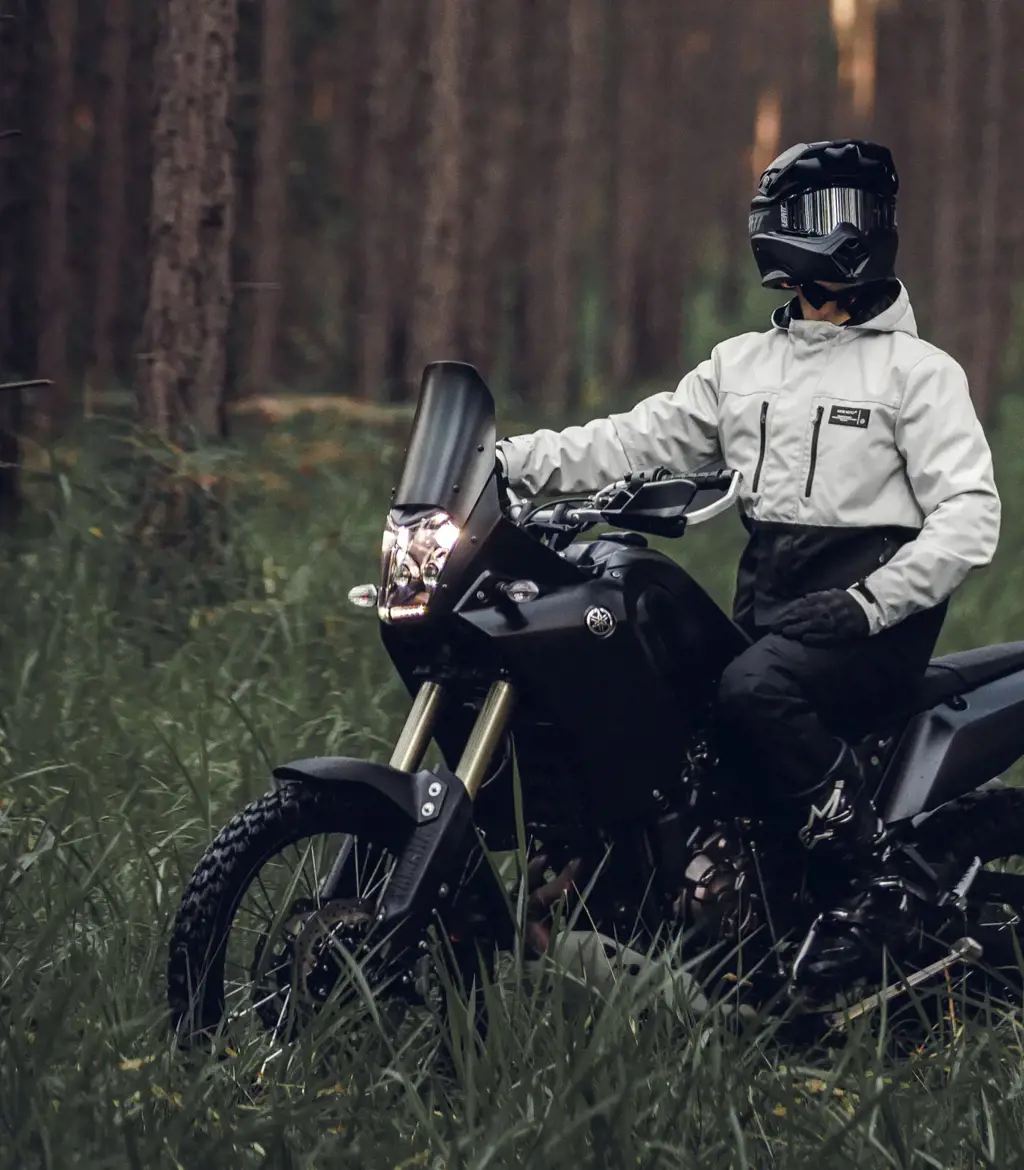
When it comes to riding a motorcycle in Canada, it's important to take into consideration the country's diverse climate. Canada experiences everything from scorching hot summers to bone-chilling winters, so choosing the right clothing is essential for staying comfortable and safe on your motorcycle.
Layering is key:
Canada's climate can be unpredictable, and temperatures can fluctuate throughout the day. Layering is essential to help regulate your body temperature. Start with a moisture-wicking base layer that will keep you dry and comfortable. Add a mid-layer that provides insulation, such as a fleece or thermal shirt. Finally, top it off with a waterproof and windproof outer layer to protect against the elements.
Invest in quality riding gear:
Investing in high-quality motorcycle-specific gear is crucial for riding comfortably in Canada's climate. Look for jackets and pants that are made from durable materials like leather or textile, and that offer both protection and ventilation. Make sure your gear has CE-certified armor in the elbows, shoulders, and knees for maximum protection in case of a fall.
Consider thermal or heated gear:
For winter riding, consider investing in thermal or heated gear. Heated jackets, gloves, and pants can make a significant difference in keeping you warm during long rides. Many of these items come with adjustable temperature controls, allowing you to customize your comfort level.
Don't forget about your extremities:
In colder temperatures, it's essential to keep your extremities warm. Look for insulated gloves that offer both protection and dexterity. Consider wearing thermal socks or heated insoles to keep your feet warm. You may also want to invest in a balaclava or a neck gaiter to protect your face and neck from cold wind.
Stay visible:
Regardless of the season, it's vital to prioritize safety by wearing high-visibility gear. Choose jackets or vests with reflective strips to make yourself more visible to other drivers, especially during low-light conditions.
Adapt your gear for different seasons:
It's important to adapt your riding gear depending on the season. In the summer, opt for lightweight and breathable materials that offer good airflow. Look for gear with ventilation panels and removable liners to help cool you down. In the winter, focus on insulation and water resistance to keep you warm and dry.
In conclusion, when riding a motorcycle in Canada, it's crucial to choose the right clothing to suit the country's diverse climate. Layering, investing in quality gear, considering thermal or heated options, and taking care of your extremities are all essential. Additionally, staying visible and adapting your gear for different seasons will ensure a comfortable and safe riding experience.
What to Pack for an Unforgettable Antarctica Cruise Experience
You may want to see also

What tools and spare parts should I bring on a motorcycle trip to Canada to ensure I'm prepared for any breakdowns or repairs?
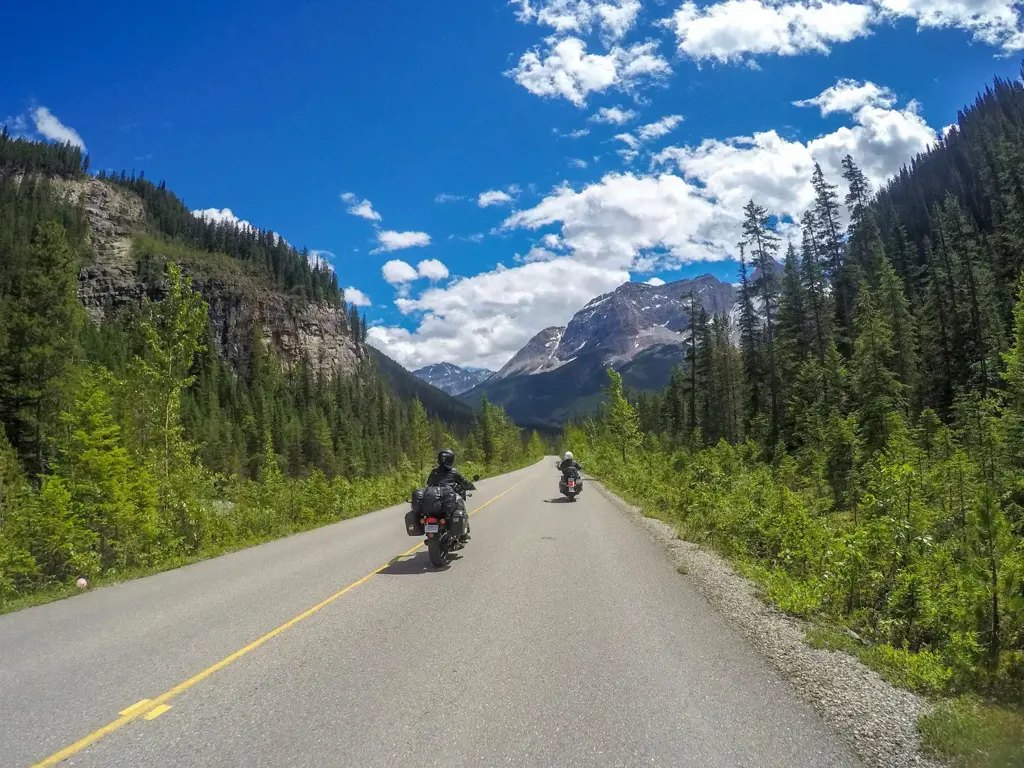
Planning a motorcycle trip to Canada can be an exciting adventure, but it's important to be prepared for any potential breakdowns or repairs along the way. From remote stretches of road to unpredictable weather conditions, there are several factors that can contribute to the need for repairs. To ensure you're equipped for any situation, it's essential to bring along the right tools and spare parts.
One of the most basic tools you should have with you is a comprehensive toolkit. This should include a set of wrenches, sockets, screwdrivers, pliers, and other basic tools that will allow you to handle common repairs. You should also consider bringing a tire repair kit, as flat tires are one of the most common issues faced by motorcycle riders.
In addition to the basic toolkit, it's a good idea to bring along spare parts that are most likely to fail during your trip. This can include items such as spare spark plugs, fuses, and bulbs. These are relatively inexpensive to purchase and can save you a lot of time and hassle if you need to replace them on the road.
Another important consideration is to have spare fluids with you, such as engine oil and brake fluid. These fluids can be essential for maintaining the proper functioning of your motorcycle and should be checked regularly during your trip. It's also worth investing in a small funnel and container to ensure you can easily refill these fluids when needed.
If you're planning on riding in more remote areas of Canada, it's a good idea to bring along a spare fuel canister as well. This can give you peace of mind in case you find yourself running low on fuel with no nearby gas stations. It's also wise to consider carrying a portable battery charger or jumper cables, as a dead battery can leave you stranded.
Aside from tools and spare parts, it's also important to have a basic understanding of motorcycle mechanics. Before embarking on your trip, familiarize yourself with the common issues that can occur and learn how to perform simple repairs. Many motorcycle owners' manuals provide helpful guides and instructions for basic maintenance tasks.
Lastly, it's always a good idea to have a backup plan in case of major breakdowns. This can include having roadside assistance coverage or carrying a list of local motorcycle repair shops along your planned route. It's worth researching these options before your trip and having contact information readily available.
In conclusion, preparing for a motorcycle trip to Canada involves bringing along the right tools and spare parts to handle potential breakdowns or repairs. A comprehensive toolkit, spare parts, spare fluids, and a basic understanding of motorcycle mechanics are all important factors to consider. By taking these steps, you can ensure that you're well-prepared to handle any unforeseen issues that may arise during your trip. Safe travels!
Essential Items for a 20 Hour Road Trip: Your Packing Guide
You may want to see also

Are there any legal requirements or documentation I need to bring with me for a motorcycle trip in Canada?
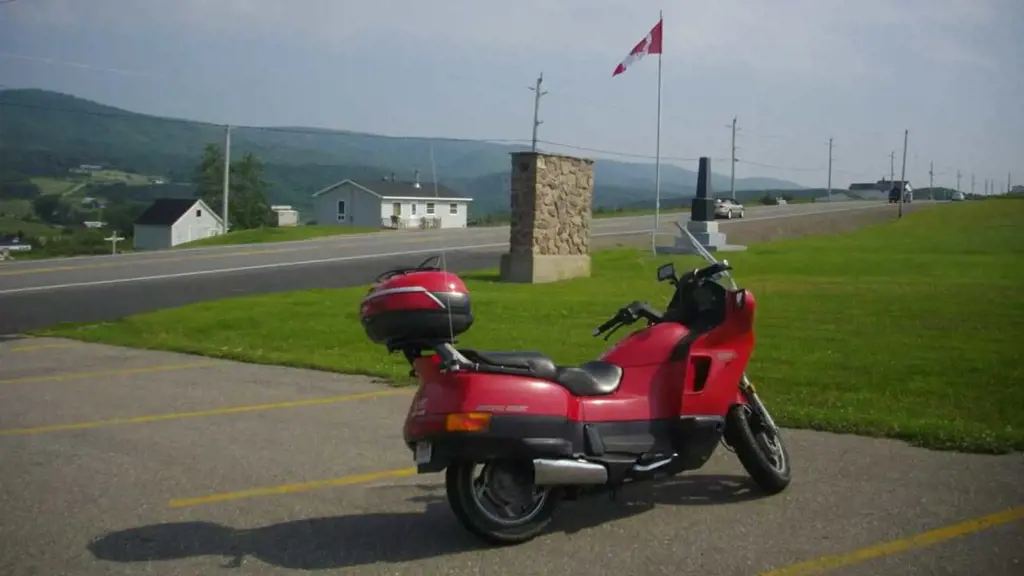
Planning a motorcycle trip in Canada can be an exhilarating adventure. The vast and diverse landscapes of this country offer stunning scenery, making it the perfect destination for motorcycle enthusiasts. However, before embarking on your journey, it is essential to familiarize yourself with the legal requirements and documentation you will need to bring with you.
- Valid Driver's License: First and foremost, you must have a valid driver's license that authorizes you to operate a motorcycle. In Canada, each province has its own licensing requirements, so ensure that your license complies with the regulations of the province you plan to visit.
- Proof of Insurance: It is mandatory to have proof of insurance coverage for your motorcycle. Before your trip, contact your insurance provider to ensure that your policy covers you for the duration of your journey. Keep a copy of your insurance certificate with you at all times while riding.
- Vehicle Registration: You must carry the vehicle registration documents with you during your trip. These documents provide proof of ownership and will be necessary if you are stopped by law enforcement. Ensure that the registration is up to date and the motorcycle is registered in your name.
- Proof of Identity: Carry a government-issued identification document, such as a passport or driver's license, as proof of your identity. This will be required if you are asked for identification at any point during your trip.
- International Driving Permit (IDP): If you are visiting Canada from another country, an International Driving Permit may be required in addition to your valid driver's license. Check with the embassy or consulate of your home country for information on obtaining an IDP.
- Travel Insurance: While not mandatory, it is highly recommended to have travel insurance that covers medical expenses and trip cancellation in case of an emergency. Accidents can happen, and having adequate insurance will give you peace of mind during your trip.
- Medical Information: It is a good idea to carry a list of any medical conditions or allergies you have, as well as your current medications. In case of an emergency, this information will be invaluable to medical professionals.
- Roadside Assistance: Consider enrolling in a roadside assistance program that covers motorcycle breakdowns. This will help ensure that you receive prompt assistance if you experience any mechanical issues during your trip.
- Route Planning: Before setting off on your journey, plan your route and be aware of any specific laws or regulations that may differ between provinces. For example, in some provinces, helmets are mandatory, while in others, they may be optional.
- Emergency Contacts: Share your travel itinerary and emergency contact information with a trusted friend or family member. In case of an emergency, they will be able to assist you or pass on important information to the authorities.
Remember, these requirements and documentation are subject to change, so it is always a good idea to check with the appropriate authorities or consult a lawyer specializing in driving laws before your trip. By ensuring that you have all the necessary documents in order, you can fully enjoy your motorcycle trip in Canada while complying with the law.
Preparing for a CrossFit Competition: Essential Gear and Supplies to Pack
You may want to see also

Are there any specific safety gear or accessories that are recommended for a motorcycle trip to Canada?
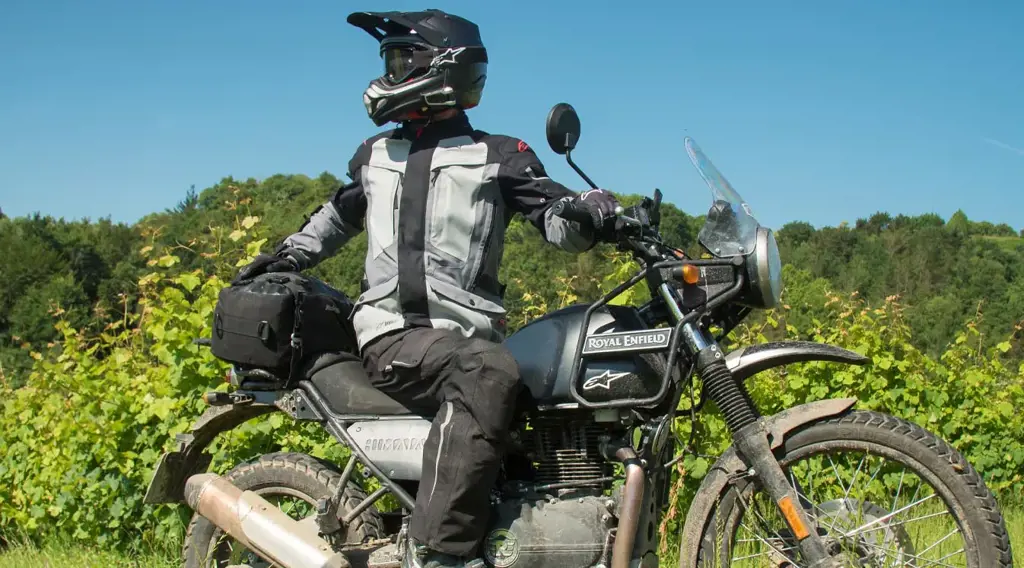
When planning a motorcycle trip to Canada, it is essential to prioritize safety and take appropriate precautions. Canada offers breathtaking landscapes and scenic routes, but it is crucial to prepare well to ensure a safe and enjoyable experience. Here are some recommended safety gear and accessories to consider before embarking on your motorcycle adventure in Canada.
- Helmet: Wearing a helmet is not only mandatory in Canada but also a critical safety measure. Look for a helmet that meets the safety standards set by the Canadian Standards Association (CSA) or the Department of Transportation (DOT). Make sure it fits properly and provides adequate protection for your head in case of an accident.
- Riding Jacket: A good-quality riding jacket is an essential piece of gear that offers protection against wind, rain, and road debris. Look for jackets made with durable materials such as Cordura or leather, which provide abrasion resistance. Ensure the jacket has built-in armor for impact protection in critical areas like the shoulders, elbows, and spine.
- Gloves: Motorcycle gloves are crucial for maintaining a firm grip on the handlebars and protecting your hands from the elements and potential injury. Look for gloves made with abrasion-resistant materials, such as leather or Kevlar, and ensure they have a snug fit. Consider gloves with built-in armor for added protection.
- Riding Pants: Investing in a pair of motorcycle-specific riding pants is highly recommended. These pants are designed to withstand abrasion and offer impact protection. Look for pants made with durable materials like Kevlar or Cordura, with built-in knee and hip armor. They should provide a comfortable fit and allow freedom of movement.
- Boots: Sturdy, over-the-ankle boots are essential for protecting your feet and ankles while riding. Look for boots with non-slip soles, reinforced toe and heel areas, and ankle support. They should be waterproof and made with durable materials to withstand the rigors of motorcycle riding.
- Reflective Gear: Enhancing your visibility on the roads is crucial, especially during low-light conditions or inclement weather. Consider wearing a reflective vest or adding reflective strips to your gear. This will make you more visible to other motorists, reducing the risk of accidents.
- Rain Gear: Canada's weather can be unpredictable, and rain is a common occurrence. Investing in waterproof rain gear, including a jacket and pants, will keep you dry and comfortable during wet conditions. Look for gear made with breathable materials to prevent excessive sweating.
- Communication System: A reliable communication system, such as a helmet-mounted intercom or Bluetooth headset, can enhance safety on group rides or when traveling with a passenger. It allows for easy communication and helps keep everyone informed about road conditions or any potential hazards.
- First Aid Kit: Carrying a well-stocked first aid kit is essential for any motorcycle trip, including in Canada. Ensure it contains basic supplies like bandages, antiseptic wipes, pain relievers, and any necessary prescription medications. It's also a good idea to have a basic understanding of first aid procedures.
- GPS System or Map: Navigating Canada's vast and diverse landscapes can be challenging, so having a GPS system or a detailed map is crucial. It will help you find your way and plan your route effectively, reducing the risk of getting lost or ending up in unfamiliar areas.
Remember, safety should always be a top priority when embarking on a motorcycle trip. Investing in the right safety gear and accessories will not only enhance your safety but also contribute to a more enjoyable and memorable experience. Stay prepared, stay safe, and enjoy the beauty of Canada from the seat of your motorcycle.
Essential Packing Tips for Your Punta Cana Vacation
You may want to see also
Frequently asked questions
Yes, it is highly recommended to pack extra layers of clothing for a motorcycle trip to Canada. The weather in Canada can be unpredictable, especially in mountainous regions or during transitional seasons. It is common to experience sudden drops in temperature, so having additional layers will help you stay warm and comfortable while riding.
When packing for a motorcycle trip to Canada, it is important to include a good set of rain gear. Look for water-resistant or waterproof materials that will keep you dry during rain showers. Consider including a rain jacket, rain pants, and waterproof gloves for full coverage. It is also advisable to pack a rain cover for your motorcycle to protect it from the elements.
In addition to the essentials such as clothing, toiletries, and a first aid kit, there are a few specific items you should consider packing for a motorcycle trip to Canada. It is essential to bring a good quality helmet that meets safety standards. Additionally, consider packing a small tool kit, tire repair kit, and spare parts for your motorcycle in case of any mechanical issues. It is also helpful to have a paper map or a GPS device to navigate the Canadian roads. Finally, don't forget to pack any necessary documents such as your driver's license, passport, and proof of insurance.






